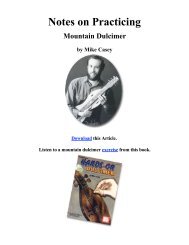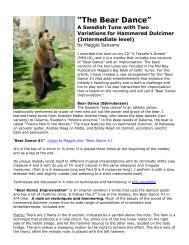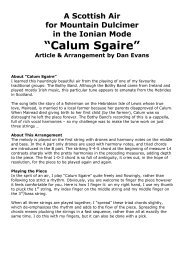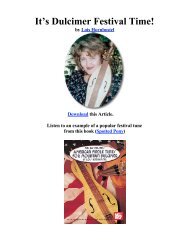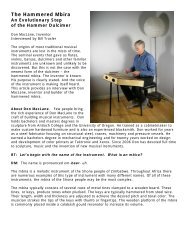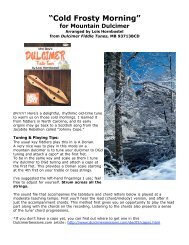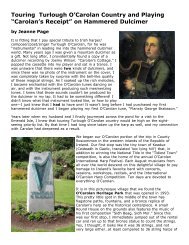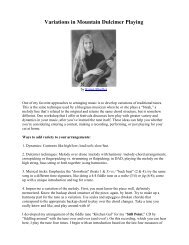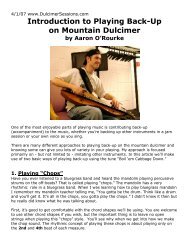You also want an ePaper? Increase the reach of your titles
YUMPU automatically turns print PDFs into web optimized ePapers that Google loves.
Leo Kretzner on Rhythm (Part 1)<br />
Hand Coordination Patterns<br />
for Mountain and Hammered<br />
Dulcimer Players<br />
Editor’s Note: Multi-instrumentalist Leo Kretzner is what I<br />
call the quintessential mountain dulcimer player. He is one of<br />
the most beautifully rhythmic musicians I know - rock-solid<br />
even at very fast tempos. His playing is full of subtlety,<br />
dynamics and syncopations. And he makes it look easy!<br />
Before Leo played mountain dulcimer and guitar he was a<br />
drummer, and he shares here some drumming exercises and<br />
rhythm tips he has used to get that great rhythm in his<br />
playing.<br />
I’m glad to finally be writing something for <strong>this</strong> fine web site!<br />
The past few years for me have been very busy and full of<br />
challenges. I have kept playing and doing a little performing,<br />
but I haven’t had time for more writing, recording, and<br />
traveling - until now! I hope to make <strong>this</strong> the first of a series<br />
on Rhythm.<br />
Lois had asked me to write an article of hand coordination<br />
exercises for mountain dulcimer players on rhythm, but<br />
these should also be of value to hammered dulcimer players.<br />
In recent months rhythm has been my focus more than ever. Fate stepped in when an SUV rearended<br />
my car and I broke my left hand. Not a serious injury as these things go - the outside<br />
palm bone, behind the pinky (5th metacarpal) - but it changed my personal music scene a lot for<br />
these past many weeks: All I could play was rhythm!<br />
Suddenly I was forced to do what I always recommend to students: Practice with the right hand<br />
alone! I quickly realized to my own chagrin that I hadn’t really done <strong>this</strong> in quite a while, and it<br />
does feel different from “regular” playing!<br />
This made me more aware that all fretted instrument players take the right (rhythm) hand for<br />
granted because we focus so much on the notes (the positions of the fingers, the chords, etc.).<br />
But the rhythm hand plays a major role in the overall music. This is more obvious in hammered<br />
dulcimer playing, where the hands work similarly. For all players though, the notes, be they<br />
many of few, need to be played with a good sense of rhythm to sound their best.
Leo having to make good use of the rhythm hand!<br />
We all have an inherent sense of “feeling the rhythm.” Though we differ in the extent to which<br />
we have that sense, <strong>this</strong> feeling of rhythm is very much not genetic but learned. The fun of<br />
getting into and actually playing rhythms is letting yourself ‘go with’ something fairly intuitive<br />
that can always be developed more, no matter what level you are currently at.<br />
Something for Both Hammered and Mountain Dulcimer Players<br />
I want to share with you <strong>this</strong> time a collection of “hand plays” that will help you further<br />
develop both your feeling for rhythm and your skill in putting it out there for the listener,<br />
including yourself. I learned most of these while taking drum lessons, but their usefulness for<br />
building hands-on rhythm skills is universal.<br />
To develop “deep rhythm instincts” I’m suggesting in <strong>this</strong> case that you try playing just rhythms<br />
in some very basic, even primal way. No thinking of notes!! No open strings! In fact, no<br />
instrument other than you yourself is even better: use your hands and/or feet!<br />
For all of us, it’s a matter of getting our hands in sync with each other. The simplest way is to<br />
just alternate hand slaps on your knees: Right-Left-Right-Left-Right-Left-Right-Left … Slow or<br />
fast, keep them even sounding. Now, go quite slow and very gradually go faster. Imagine the<br />
classic steam locomotive pulling out of the station. Get it up to cruising speed, hold it there while<br />
you can, and then gradually slow it down, bringing it into the next ‘station’. (Later you can try<br />
these with your pick or hammers, but keep the focus on the hand motion – play a single note, or<br />
even muted strings.)
Now, you can also go from ‘slow’ to ‘fast’ in a distinct step, doubling the slaps per beat:<br />
R L R L R L R L R L R L R L R L R L R L R L R L R …<br />
1 2 3 4 1 & 2 & 3 & 4 & 1 2 3 4 1 & 2 & 3 & 4 & 1 …<br />
“I am cra-ving rutabaga ru-ta-ba-ga…”<br />
Having a phrase that captures the rhythm can really help, especially on the double-time notes. For these, some<br />
of a certain age may remember “Good and Plen-ty, Good and Plen-ty…” If <strong>this</strong> doesn’t ring a bell, try “Ma-care-na,<br />
Ma-ca-re-na…” or anything else you like!<br />
A Further Step<br />
Next try combining the distinct doubling just above with the ‘train’: Play the above very slowly and then<br />
gradually speed up, get to cruising speed and hold it a bit… and then gradually slow it down again. Gradually<br />
slowing down is as important as getting it to go faster, perhaps even more important – it’s all about trying to<br />
keep it smooth, relaxed, and even.<br />
Did someone say “relaxed”? Yeah, <strong>this</strong> is a challenge when your hands move faster and you are literally<br />
working harder. It may be a Zen-like, paradoxical-sounding goal, and certainly one I still strive to improve at.<br />
But the secret is to first be aware of your hands – look at them, don’t just stare into space. Then, perhaps you’ll<br />
need to not think about it all, but aim to just let it happen.<br />
Either way, try to keep yourself and your hands in particular as relaxed as possible. You won’t have a chance to<br />
think about <strong>this</strong> much at all once you’re back to playing those notes and chords, so <strong>this</strong> is your opportunity to<br />
focus on mindfully creating good patterns.<br />
Hand-to-Hand Patterns: Trying Some “Hand Play”<br />
‘Doubles’<br />
R R L L R R L L R R L L R R L L…and vice versa: L L R R L L R R L L R R L L R R<br />
1 & 2 & 3 & 4 & 1 & 2 & 3 & 4 &<br />
Or think:<br />
“1 e & a 2 e & a 3 e & a 4 e & a…”<br />
R R L L R R L L R R L L R R L L…<br />
“Ru-ta-ba-ga ru-ta-ba ga…”<br />
and vice versa: L L R R L L R R L L R R L L R R<br />
“1 e & a 2 e & a 3 e & a 4 e & a…<br />
(My drum teacher said one should be able to play any pattern equally well starting with the left or the right –<br />
sounds reasonable enough, but you have to work against your natural handedness! Many times I thought, “Mr.<br />
Stewart, that’s so much easier said than done…” Now I realize he of course knew that.)<br />
The above pattern is actually how drummers do ‘rolls’, the sticks quickly bouncing to make the repeated strike when up to<br />
speed. For our purposes, it’s to get us rolling with the feeling of the rhythm – but also notice how these ‘doubles’ do<br />
sound different from purely alternating notes. This is virtually always true of slightly different ways of playing the same<br />
thing, and something to always be listening for in your own and others’ music.<br />
‘Paradiddles’
I kid you not, <strong>this</strong> is really what <strong>this</strong> hand motion is called when taught as a drumming rudiment. It’s another<br />
good word to say with <strong>this</strong> and the rhythms above, too. It’s an alternation followed by a double, then an<br />
alternation followed by a double, and so on. The cool (ie, challenging) thing about it is that the lead hand for<br />
each set of four notes ends up alternating:<br />
R L R R / L R L L / R L R R / L R L L …<br />
1 e & a 2 e & a 1 e & a 2 e & a<br />
“pa-ra-did-le pa-ra-did-le pa-ra-did-le pa-ra-did-le …”<br />
If <strong>this</strong> seems completely elusive, in fairness we should back up and first do alternating hands followed by<br />
double-hands where each one lasts a bit longer. The asterisks mark the transitions:<br />
R L R L R L R L R L R L R L R L *R R L L R R L L R R L L R R L L *R L R L R L R L etc.<br />
1… 2 … 3… 4… 1… 2 … 3… 4… 1… 2 …<br />
Next try just two beats for each pattern. (Go on, try it with your hands – don’t just sit there reading! : )<br />
R L R L R L R L *R R L L R R L L *R L R L R L R L *R R L L R R L L<br />
1… 2 … 3… 4… 1… 2 … 3… 4…<br />
And then just one beat of each pattern:<br />
R L R L *R R L L *R L R L *R R L L *R L R L *R R L L *R L R L *R R L L<br />
1… 2 … 3… 4… 1… 2 … 3… 4…<br />
Realistically, you may need to play with each of these a bit before you go back and do the paradiddle:<br />
R L R R / L R L L / R L R R / L R L L …<br />
1 e & a 2 e & a 1 e & a 2 e & a …<br />
“pa-ra-did-le pa-ra-did-le pa-ra-did-le pa-ra-did-le …”<br />
There are also double and triple paradiddles that I won’t torture you with! But I will show you the “paradiddlediddle,”<br />
which at least mercifully leads with the same hand every time:<br />
R L R R L L / R L R R L L / R L R R L L / R L R R L L /<br />
1 e & a 2 a 1 e & a 2 a 1 e & a 2 a 1 e & a 2 a<br />
You can also count <strong>this</strong> like a waltz:<br />
R L R R L L / R L R R L L<br />
1 & 2 & 3 & 1 & 2 & 3 &<br />
This leads to our next set of hand games…<br />
‘Splits’ (waltz time when slow, jig time when faster) Many ways to do <strong>this</strong>:<br />
R L L R L L R L L R L L … or: R R L R R L R R L R R L…<br />
1 & a 2 & a 1 & a 2 & a 1 & a 2 & a 1 & a 2 & a<br />
“Vi-en-na Vi-en-na (for waltzes) “I-re-land I-re-land (for jigs) These also can be counted:<br />
1 2 3 1 2 3 … 1 2 3 4 5 6 …
Also of course vice versa, ie switching the starting hand:<br />
L R R L R R L R R L R R… and: L L R L L R L L R L L R…<br />
1 & a 2 & a 1 & a 2 & a 1 & a 2 & a 1 & a 2 & a<br />
(1 2 3 1 2 3 … 1 2 3 4 5 6 …<br />
‘Splits’ with a Difference<br />
Now notice what happens if you keep thinking of <strong>this</strong> ‘three’ rhythm but simply alternate hands:<br />
L R L R L R L R L R L R… L R L R L R L R L R L R…<br />
1 & a 2 & a 1 & a 2 & a…or 1 2 3 4 5 6 1 2 3 4 5 6 …<br />
It sounds almost identical, but feels different – why? Now each strong beat (1 2 3 1 2 3 in a waltz, 1 2 3 4 5 6<br />
for jigs) has an alternating hand playing it, not the same hand every time. It’s the same little twist you<br />
encountered when doing the paradiddle. Dulcimer-wise, you’ll face a similar choice when you get back to<br />
playing actual pieces with a ‘three’ (waltz) or ‘six’ timing (jig): Sometimes it will be easier to play two beats<br />
with the same hand, while other times it will be more natural to just alternate hands. For fretted instrument<br />
players <strong>this</strong> translates to a choice between strumming twice in the same direction followed by a strum in the<br />
opposite, versus pure alternation of strum directions, as follows.<br />
Two strums in one direction: out-out-in, out-out-in, out-out-in, out-out-in (or, in-in-out, in-in-out…)<br />
1 2 3 1 2 3 1 2 3 1 2 3 1 2 3 1 2 3<br />
Pure alternation: out-in-out, in-out-in, out-in-out, in-out-in (or, starting with an ‘in’ strum first)<br />
1 2 3 1 2 3 1 2 3 1 2 3<br />
All <strong>this</strong> “In and Out” reminds me of our local California hamburger chain of the same name, and has me<br />
craving a cheeseburger with fries. So, for health’s sake, let’s get back to our veggie root crops!<br />
Rutabagas with Attitude! There’s a very important thing that should happen with any rhythm, which is<br />
making it come more to life by adding a distinct pulse or accent. Rhythm without pulse is like soup without<br />
seasoning - somehow lacking something.<br />
To make an accent, make a harder slap on your knee on certain beats (or a harder hammer or harder strum on<br />
your instrument). Now, deciding which note the accent falls on begins to make a big difference! Try it with<br />
your rutabagas. First, accent the first syllable: RU-ta-ba-ga RU-ta-ba-ga:<br />
R L R L R L R L R L R L R L R L<br />
1 & 2 & 1 & 2 & 1 & 2 & 1 & 2 &<br />
RU-ta-ba-ga RU-ta-ba-ga RU-ta-ba-ga RU-ta-ba-ga<br />
This creates what I call the “Indian tom-tom rhythm,” at least as it’s been stereotypically portrayed in movies<br />
and television: Boom-boom-boom-boom Boom-boom-boom-boom… It’s a good, strong pulse, no doubt about<br />
it. But now put the accent in the middle of the word: ru-ta-BA-ga ru-ta-BA-ga:<br />
R L R L R L R L R L R L R L R L<br />
1 & 2 & 1 & 2 & 1 & 2 & 1 & 2 &<br />
ru-ta-BA-ga ru-ta-BA-ga ru-ta-BA-ga ru-ta-BA-ga
Very different feeling! Perhaps you are tapping your foot to help keep time. If so, perhaps you are tapping it<br />
only on the “1” beats above; if not, try doing that:<br />
R L R L R L R L R L R L R L R L<br />
1 & 2 & 1 & 2 & 1 & 2 & 1 & 2 &<br />
ru-ta-BA-ga ru-ta-BA-ga ru-ta-BA-ga ru-ta-BA-ga<br />
tap… tap… tap… tap…<br />
A simpler version of <strong>this</strong> is simply:<br />
foot – clap – foot – clap – foot – clap – foot – clap (Make the claps louder than your foot taps.)<br />
1 2 1 2 1 2 1 2<br />
ru-ta-BA-ga ru-ta- BA-ga ru-ta-BA-ga ru-ta-BA-ga<br />
Because we all have a natural tendency to tap our feet on the first beat (the “downbeat”), playing the first<br />
pattern – accent on the 1 or ‘RU’ – and adding the clap for accent becomes <strong>this</strong>:<br />
foot foot foot foot<br />
clap clap clap clap<br />
1 & 2 & 1 & 2 & 1 & 2 & 1 & 2 &<br />
RU-ta-ba-ga RU-ta-ba-ga RU-ta-ba-ga RU-ta-ba-ga<br />
Which one sounds better? The second pattern, for sure: ru-ta-BA-ga ru-ta-BA-ga…<br />
1 2 1 2<br />
Why? It somehow has more ‘lift.’ In terms of beats, if the ‘one’ is the downbeat, then the ‘two’ is the upbeat,<br />
and <strong>this</strong> is an upbeat accent pattern. Or, rutabagas with attitude! It will virtually always sound more lively than<br />
accenting the downbeat. Listen for it in music you hear. This isn’t to say that a downbeat accent is never good.<br />
Besides the fact that some pulse is better than no pulse (which is when the ‘patient’ is dead), many marches and<br />
march-like songs have a nice sounding downbeat accent:<br />
YANK-ee doodle WENT to town, RID-ing on a PO-ny…<br />
But in many songs, too much downbeat accent can seem to weigh things down – though it’s also a matter of<br />
what the individual likes. Compare these two approaches to ‘Sally Goodin’…<br />
Downbeat accent:<br />
HAD a piece of PIE and I HAD a piece of PUD-din’<br />
GAVE it all a-WAY for the SEE Sally GOOD-in.<br />
Versus the upbeat accent:<br />
Had a PIECE of pie AND I had a PIECE of pudin’ -,<br />
Gave it ALL away FOR to see SAL-ly Goodin - .<br />
As in <strong>this</strong> example, sometimes the upbeat falls where there is no lyric: the dashes after ‘puddin’ and ‘Goodin’. It<br />
doesn’t matter - the second version still has an upbeat feeling from the words and syllables that are on the<br />
upbeats. Of course, when you’re playing something like <strong>this</strong> with your instrument you can put in a nice,<br />
accented strum in that place.<br />
To get more of a feeling for <strong>this</strong>, try it with the “foot – clap”
Had a PIECE of pie AND I had a PIECE of pudin’ -<br />
Foot clap foot clap foot clap foot clap<br />
1 2 1 2 1 2 1 2<br />
Gave it ALL away FOR to see SAL-ly Goodin -<br />
Foot clap foot clap foot clap foot clap<br />
1 2 1 2 1 2 1 2<br />
LAST BUT NOT LEAST, SOMETHING COMPLETELY DIFFERENT<br />
Often when we’re playing, our hands are doing two slightly (or greatly) different things – bass versus treble on<br />
the hammered dulcimer (piano, etc) or strumming versus fretting notes on the mountain dulcimer. Is there any<br />
simple hand-play that can help us get better at <strong>this</strong>? Of course there is – or I wouldn’t have asked the question!<br />
Here are some patterns to try:<br />
Right hand: tap tap tap tap tap tap tap tap<br />
1 & 2 & 3 & 4 & 1 & 2 & 3 & 4 &<br />
Left hand: tap tap tap tap tap tap tap tap tap tap tap tap tap tap tap tap<br />
Or you might find it easier the other way:<br />
Right hand: tap tap tap tap tap tap tap tap tap tap tap tap tap tap tap tap<br />
1 & 2 & 3 & 4 & 1 & 2 & 3 & 4 &<br />
Left hand: tap tap tap tap tap tap tap tap<br />
Or, think of it <strong>this</strong> way: R R R R R R R R R R R R R R<br />
L L L L L L L<br />
Here’s a good variation on that, especially for fretted players. This time use the Index and Middle fingers of the<br />
left hand, perhaps on a table top<br />
Left: I M I M I M I M I M I M I M I M …<br />
Right: tap tap tap tap tap tap tap tap …<br />
Or, the other way with the left hand fingers, ie middle first (on the downbeat):<br />
Left: M I M I M I M I M I M I M I M I …<br />
Right: tap tap tap tap tap tap tap tap …<br />
I hope you can see how the ‘taps’ would become a strum, and the two separate fingers might be a hammer-on,<br />
or slide, or pull-off.<br />
One more hand-to-hand play:<br />
Right hand: tap tap tap tap tap tap tap tap<br />
1 & a 2 & 1 & a 2 & 1 & a 2 & 1 & a 2 &<br />
Left hand: tap-tap tap tap-tap tap tap-tap tap tap-tap tap<br />
In <strong>this</strong> one, each hand plays ‘solo’ on its beats – they never play together here, but alternate.<br />
A simple warm-up for <strong>this</strong> is our very first pattern, way above: R L R L R L R L
This is the same as: R R R R R … or R hand: tap tap tap<br />
L L L L L hand: tap tap tap<br />
Now go to: R LL R L / R LL R L / R LL R L / R LL R L<br />
1 & a 2 & 1 & a 2 & 1 & a 2 & 1 & a 2 &<br />
If you make the left hand louder than the right, you’ll get a nice upbeat accent:<br />
R LL R L / R LL R L / R LL R L / R LL R L<br />
1 & a 2 & 1 & a 2 & 1 & a 2 & 1 & a 2 &<br />
NOW YOU’RE OFF AND ROLLING – HAPPY RHYTHMIC PLAYING!<br />
Next time: Applying these rhythms to strumming patterns for fretted players.
About the Author<br />
Leo Kretzner, middle, and “The Old Grey Cats”<br />
I began playing the mountain dulcimer in early 1975. Initially inspired by local folkies around my<br />
hometown of Detroit, I became totally hooked upon having a chance to sit and play one for a<br />
couple hours. I played it more or less like a guitar in my lap, just goofing around but loving it.<br />
Visiting a friend in Vermont I had the great fortune to see Margaret MacArthur in concert, and<br />
was intrigued and mystified by the many ‘extra’ notes she made on the instrument. I returned to<br />
New England that summer and took a wonderful week of classes with Margaret at the Pinewoods<br />
Folk Music Camp, learning a few specific tunes using the secrets of hammer-ons and pull-offs.<br />
My basic course for the next ten years was set, especially when I found I could use a driving<br />
strumming rhythm with my right hand when Margaret’s finger-picking style eluded me.<br />
In Ohio two years later I met Jay Leibowitz, who invited me to join him on an album some folks<br />
were making, which became “Dulcimer Fair.” That was followed by “Pigtown Fling” and my<br />
moving to Connecticut. I met Lorraine Lee and it was like two worlds colliding, but with mutual<br />
fascination: She used an A-D-D tuning with no real bass and got beautiful, full, high chords,<br />
while I used D-A-D and got in lower voiced chords and bass runs. Neither of us could play the<br />
other’s music! Seeing her a year later, we’d both gone to four equidistant strings, which we’ve<br />
each played ever since – the best of both worlds in my book.<br />
Over time I branched out more and more from playing fiddle tunes, adding songs of all genres<br />
from Irish and Appalachian to blues and rock. Having spent my teenage musical years as a<br />
drummer, the latter excursions actually felt very familiar to me, while the older traditional<br />
material - deceptively ‘simple’ - felt like something I needed and wanted to spend countless<br />
hours absorbing from people and recordings, to capture its real beauty and essential sound. I’ve<br />
occasionally written a song or two, and my performances are an amalgam of all these things. A<br />
purist I never have been!<br />
I played music full time for a few years in the mid 80’s while living in the Boston area, and then<br />
returned to school to get a degree enabling me to do biomedical research. I’ve moved around<br />
quite a bit, out of desire or necessity, and now reside in Claremont, CA, about forty miles east of<br />
Los Angeles. I work at the City of Hope National Medical Center, and have continued playing<br />
dulcimer and guitar as often as possible. Even without playing full time, it’s been wonderful to be<br />
at various festivals all around the country.
I’ve had periods of activity and inactivity with music and festivals, and I’m now in a position to<br />
become more active again. A couple years ago I had a total blast playing electric guitar for a<br />
stage presentation of The Who’s “Tommy,” and also played dulcimer on a couple quieter pieces.<br />
I’m currently playing with a Celtic string band (with an old-timey name), “The Old Grey Cats.”<br />
I’ve done a bit of playing for an “Indigo Girls’” ‘tribute’ band here. So, I remain musically<br />
adventurous! While mindful of stylistic differences between various genres, I like to keep my<br />
‘passport’ updated to cross over their borders whenever the mood and opportunity arises.<br />
Leo Kretzner contacts:<br />
www.leokretzner.com (In progress but hopefully presentable by the time the article is posted.)<br />
leoleo1@verizon.net<br />
CD’s by Leo:<br />
“Dulcimer Fling!” - A compilation of the first two albums, “Dulcimer Fair” and “Pigtown Fling.”<br />
It is all instrumental and all traditional tunes, both old-time and Irish.<br />
“Bold Orion” – A mixture of traditional and contemporary, vocal and instrumental. Includes the<br />
title song, “Little Martha,” “Dark is the Color” and fiddle tunes with Jay Unger.<br />
“Not So Still Life” – Another mix of old and new, instrumentals and vocals. Dulcimer on every<br />
selection. Includes the title piece, “Devil Don’t Rule My Life” and “Walking Blues.”



